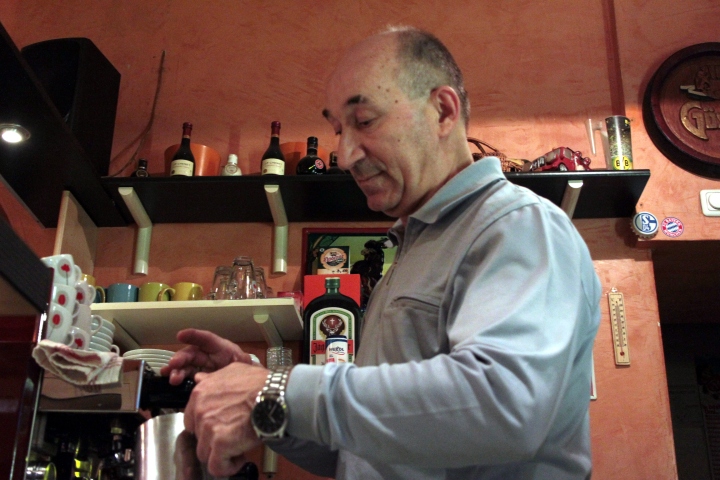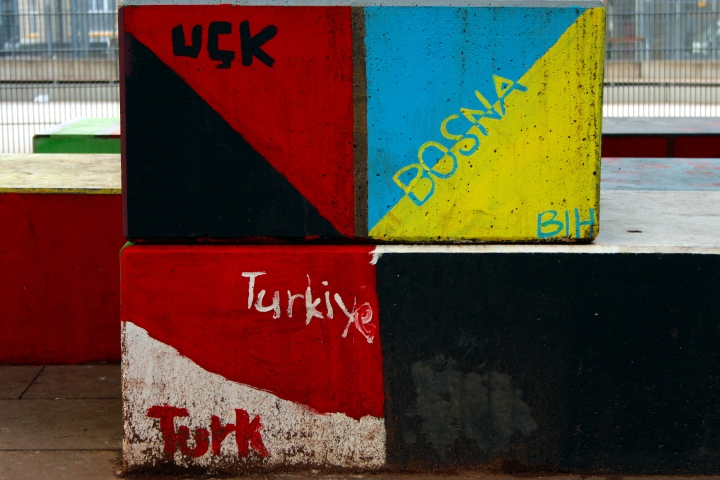Almost 200.000 Viennese were born in Ex-Yugoslavia or born to parents who were. That is around 10 per cent of the city’s population. Most of them live in working class neighborhoods. Like the one I live in. A photo essay.

Jovica Dimitrievski is making milk foam for one last coffee tonight. Jovica was born in Macedonia and has had his own cafe – Cafe Club Horizont – for a couple of years now. Peter, one of the regulars here, is one of Jovica’s last patrons tonight. He’s from near the Czech border.
Peter, one of the regulars here, is one of Jovica’s last patrons tonight. He’s from near the Czech border.
Jovica’s place is one of few working class cafes still around in this particular corner of the neighborhood that has largely turned middle class in the past few years.
 „Top Grill“’s kitchen has closed for tonight. Time for owner Saša Badjević from Serbia and his employees to join their last guests for a drink.
„Top Grill“’s kitchen has closed for tonight. Time for owner Saša Badjević from Serbia and his employees to join their last guests for a drink.
In this roštilj you can get a full meal of traditional Balkan barbecue for as little as 3 Euros 50.

Brunnenmarkt is one of Europe’s largest permanent open air markets. The vendors come from all over the world, Turks and people from Ex-YU being the largest groups. So there are a lot of Serbian and Croatian specialties to be had, like at this kiosk.

This Burek Restaurant in Vienna’s 15th district is a memory of better times. „The Olympic Winter Games in Sarajevo in 1984 are something that still brings people from all countries from Ex-Yugoslavia together, especially here“, the owner tells me.
Since I’m a new customer he immediately treats me to a cheese pita.

Teenagers will document they’re in love all over the world. Some write poems, some are more pragmatic and write graffiti.
Then again, maybe this isn’t Jena and Kičo making visible their affection for each other but some schoolfriends mocking either one of them for his or her obvious infatuation.

This is something you don’t see every day. In fact, there probably aren’t too many cafes anywhere that have both Vesti and Večernji list.
Vesti is a Serbian language tabloid produced and printed in Germany for the Serb diaspora.
Večernji list is a tabloid from Croatia. It is owned by a publisher that belongs to the (Catholic) Episcopal See in Graz.
In Vienna, usually a Serbian place wouldn’t have Večernji list and Croatians wouldn’t offer their guests Vesti. But apparently there are exceptions.
Hail the Internationale of the gullible.

Local youths, presumably of Bosnjak origin, have felt the need to decorate concrete blocks in front a playground.
The choice of motives suggests that there are some who would like to construct a common Muslim identity between Kosovars, Bosnjaks and Turks.
Turkey invests a lot of money in Bosnia in order to create that very narrative. While this is a minority position both in Bosnia and here it has apparently fallen on fertile grounds.
The message is much more than religious. It is outright political, illustrating a growing number of Bosnjak nationalists demanding that Bosnia become a Muslim country.
Graffiti by nationalist Serb youths used to be common in the area. Most of them have disappeared recently, for whatever reasons.

The writing on this sticker has whithered away. It used to say: „Deca smo ovog grada!“ in Serbian Cyrillic. „We are children of this city“.

A not so pleasant sign of the poverty so common in most Balkan societies.
This shabby and cheap looking brothel advertises „hot Serbian girls“.
